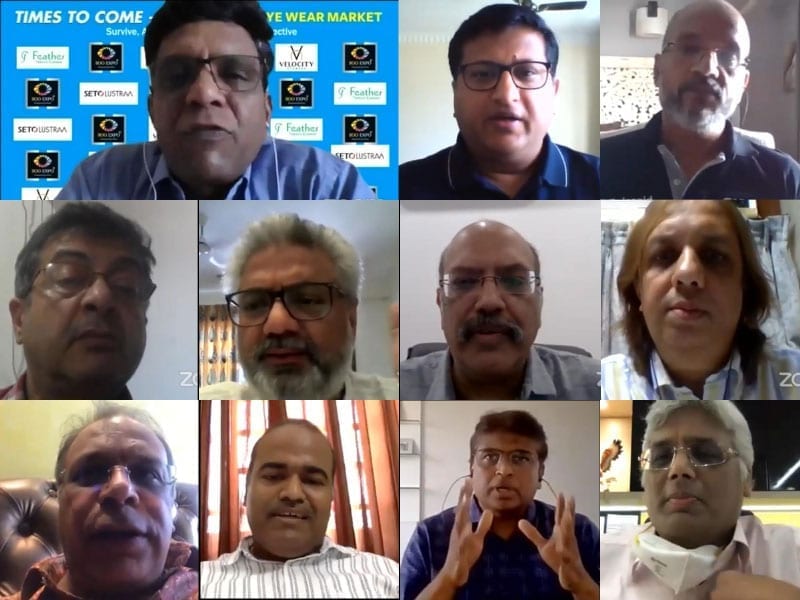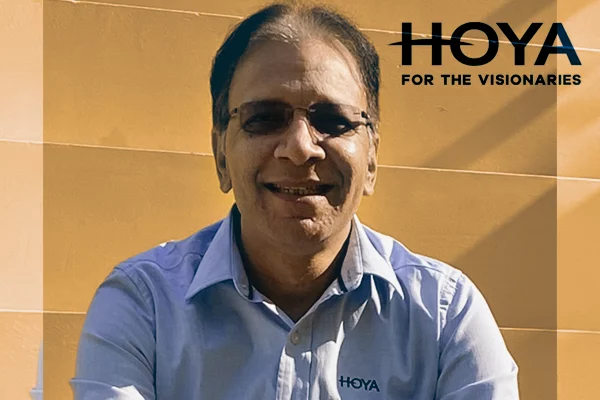This post is also available in:
![]() हिन्दी
हिन्दी
The first of its kind webinar conducted on Apr 22, 2020, lasted almost 100 minutes and turned out to be a welcome initiative by SD Promo Media. Similar programs will surely be used more frequently by the optical community for better communication in the coming days.

Speakers from different segments of the optical industry, which included retailers primarily, shared their expert insights on how the industry should get ready to handle the future that follows Corona COVID 19 lockdown.
We learnt that close to a thousand registered and joined the ‘Time to Come – Indian Retail Eye Wear Market’ webinar and over three hundred watched it live on YouTube.
The panel in the discussion had Sudarshan Binani, Sanjeev Madan, Snehal Turakhia, Pragnesh Gangar and Boman Barucha from retailers side while Devesh Gupta and Hem Garg from the sector of lens business. Ashutosh Vaidya and Akash Goyle represented eyewear products supplier segment. Dr T Senthil was from the ophthalmologists’ side. Vivek Vikram of SD Promo Media was the moderator of the webinar
The main takeaway of the discussion was that the optical retailing should be given a new look altogether starting with highlighting the importance of hygiene in handling the customers. Ensuring safety on health ground starting from the owners to all levels of employees up to security and housekeeping should become a must for every retailer. Customers should be given the guarantee that visiting your store is hygienically safe. It was also felt that a new normal will dawn for everyone in handling overall business in the coming days.
Attracting older customers by marketing activities mainly digital will make better sense and one of the new thoughts to be brought in. There was common agreement from among all panellists that the effect of Coronavirus and lockdown on optical business is going to last more than just three or six months and full recovery will take much longer time.
Also, it was debated that the effect to optical business will be much less compared to other business as eyewear is a product that is essential as a daily used product as a necessity rather than a choice.
To cope up with the current situation, there were suggestions that the community should consider the difference between a good cost and a bad cost. Spending on employees who could improve the standard of customer handling and by investing on extending the customer service at home level – not just delivery of the products but even taking testing facilities to the door of the customer being good cost for example. This was also the appropriate time to reduce ‘bad’ costs, which basically referred to unproductive elements in day to day business.
While some panellists felt there’s going to be a drop in a business turnover between 30 to 40 per cent others suggested that to cope up this the time is good to introduce newer products like Plano spectacles and projection of sunglasses as protective eyewear and introducing protective glasses may help. Demand for premium and luxury products will decline considerably was a prediction by some of the panellists.
On the topic of how to handle cash flow in the coming days, almost all panellists agreed that this is a crucial subject and the suggestion was almost common that the optical retailers should concentrate more on selling what’s already in the inventory than looking for more than what they can sell.
This perhaps means that every optician knows what sells more in his store and should judge himself on what he should store depending on his experience than acquiring products on the basis of other aspects that he comes across. The retailer community needs more support from vendors of products and would need to cooperate in working out payment terms that suits better for the business.
An interesting point was made by one of the speakers about ‘bee’ mentality of how the bee find the flower in a garbage dump, providing a sort of optimism that retailers need to change the way they look at the situation. It was a well intended analogy and seemed to change the mode of conversation to being a bit more optimistic. In fact, another example by the same speaker compared the current situation to a previous ‘coronavirus’ – the demonetisation process, some years ago. The speaker claimed that the demonetisation had in fact increased the movement of currency and people should not go by the pessimistic approach and look forward to probably a sort of ‘revenge’ shopping, where people might come out of confinement/quarantine and be eager to shop. And this sort of behaviour should be sought by opticians as an opportunity to capture their customer base.
Another interesting point made by another speaker was about shopping in malls and on high streets. Based on the fear of coronavirus and the assumption that food courts and cinemas might take a while to open, there would be increased footfalls in stores. Also, the speaker made an interesting point about luxury not getting affected much as for the luxury buyer, the products that he or she chose to buy were in fact ‘necessities’ so this category would still shop for their luxury goods.
All in all, it was an interesting talk. And I would like to have more of such interactions. I am sure there’s definitely light at the end of this tunnel. And I am looking forward to the optical community entering that lit zone soon and looking back at the current phase as a tough but well-learnt lesson.
Stay safe. Stay healthy.












